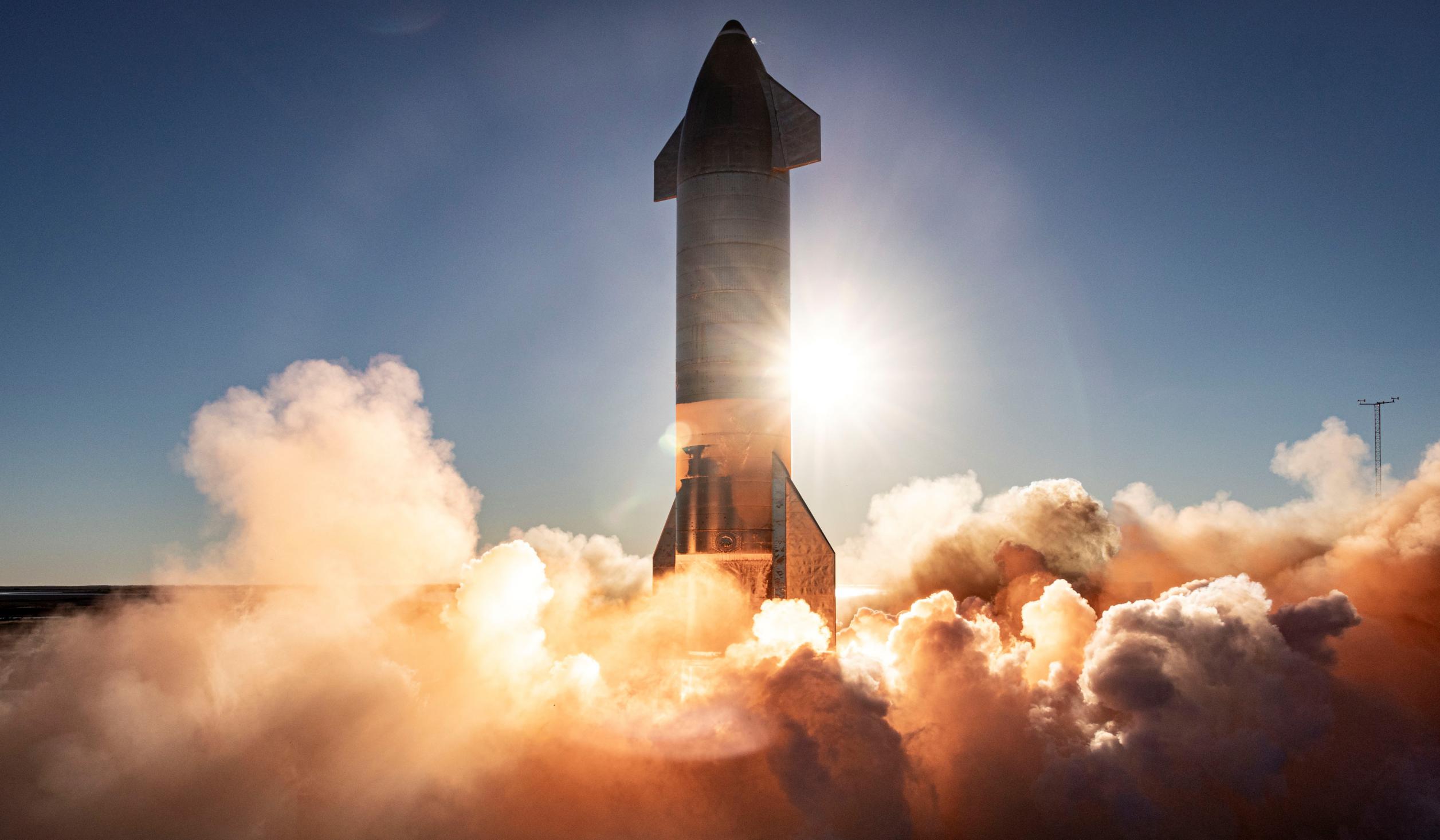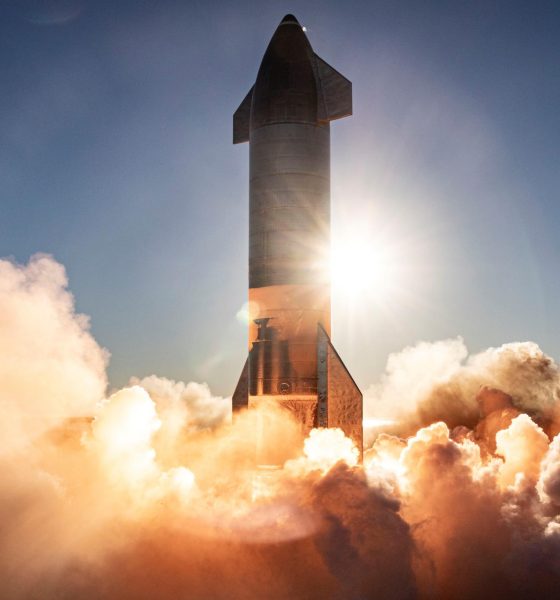

News
SpaceX Starship aborts Raptor engine test, briefly catches fire
Update: On March 15th, SpaceX got within milliseconds of Starship serial number 11’s (SN11) first Raptor engine test but suffered an abort just before full ignition, briefly leaving the rocket on fire.
Around 12:26 pm CDT, after an otherwise nominal static fire flow, Starship SN11 momentarily ignited one or two of its three Raptor engines’ preburners, referring to a central component that burns cryogenic liquid propellant into gas that’s ready for combustion. As with all preburner tests, intentional or otherwise, the end result looked a bit like a weak static fire and produced a small but visible amount of flame and thrust. Unlike intentional preburner tests, the static fire abort seemingly ignited something hidden inside Starship SN11’s and appeared to burn for at least another 30-40 seconds.
Raptor has proven itself to be an extremely durable engine, up to and including surviving visible onboard fires during actual Starship flight tests. Nevertheless, depending on the source of SN11’s post-abort fire and what it may or may not have burned or damaged, it’s no surprise that SpaceX ended testing for the day instead of quickly trying again, which it’s done several times prior. If the fire was largely harmless, SpaceX has already distributed notices suggesting a second attempt could happen as early as 6am to 12pm CDT (UTC-5) on Tuesday, March 16th. If more time is needed, SpaceX has the rest of the week to conduct any necessary repairs or swap out SN11’s Raptor engines.
Public documents show that SpaceX has plans to static fire and launch its latest Starship prototype within a two-day period that could begin later today.
SpaceX shipped Starship SN11 from its Boca Chica, Texas rocket factory to test and launch facilities a mile down the road on March 8th, less than five days after Starship SN10 exploded minutes after touchdown. The very next day, SpaceX completed ambient-temperature proof testing, filling Starship with benign nitrogen gas to check for leaks and verify system health. Two days after that, Starship SN11 appeared to complete a several-hour cryogenic proof test – swapping nitrogen gas for its supercool liquid form – without issue.
Despite the seemingly successful ‘cryo proof,’ something prevented a subsequent static fire test planned on March 12th before any attempt could be made, delaying the next attempt until after the approaching weekend. An agreement between SpaceX, Cameron County, and the state of Texas currently prevents road closures (and thus rocket testing) on weekends falling between Labor Day and Memorial Day, rules meant to preserve some level of public access to Boca Chica Beach.
As a result, unless SpaceX is already ready to launch (it has waivers for three such weekend closures for launch attempts), the company has to wait until Monday even if a minor issue fixable in hours or a day or so scrubs Friday test plans. While inconvenient, it’s worth noting that the existence of that public beach and the strong regulations that protect its public domain is likely one of the only reasons the general public can still get as close as they can to SpaceX’s Boca Chica ‘Starbase’.
For whatever reason, that road closure agreement does still mean that SpaceX will (in theory) be able to test and launch any day of the week from May 31st to September 6th, save for a few holidays, effectively boosting the number of opportunities by 40% for those 14 weeks. Until then, SpaceX is doing everything it can to take full advantage of the five days a week it is allowed to test Starship prototypes. N
Notably, although Starships SN8 and SN9 both hit a few weeks of technical and regulatory snags while preparing for their high-altitude launch attempts, SpaceX has been gradually speeding up that process over time. Starship SN10, the first prototype of its kind to land in one piece, took just 33 days to go from pad arrival to liftoff and spent just 8 days between its first static fire and launch attempts. The same feats took Starship SN8 77 and 50 days, respectively, with SN9 splitting the difference at 43 days from transport to liftoff and 28 days between its first static fire and launch attempts.
Road closure requests, a safety warning for residents, and a Temporary Flight Restriction (TFR) filed with the FAA all suggest that SpaceX’s current plan is to attempt Starship SN11’s first triple-Raptor static fire between 6am and 12pm CDT on Monday, March 15th. If that test goes almost perfectly, SpaceX wants to turn the rocket around for a 10 km (6.2 mi) launch attempt on Tuesday, March 16th – the very next day. Given the past performance of high-altitude Starship prototypes, that target is decidedly ambitious and likely to incur delays, but it still reveals the true scope of SpaceX’s goals even at this early stage of development.
If Starship SN11 does manage to launch within a few days of its first static fire attempt, SpaceX would still crush SN10’s 33-day record by a factor of three. Stay tuned for updates on Monday’s possible Starship static fire and rapid Tuesday turnaround attempt

News
Tesla FSD fleet is nearing 7 billion total miles, including 2.5 billion city miles
As can be seen on Tesla’s official FSD webpage, vehicles equipped with the system have now navigated over 6.99 billion miles.

Tesla’s Full Self-Driving (Supervised) fleet is closing in on almost 7 billion total miles driven, as per data posted by the company on its official FSD webpage.
These figures hint at the massive scale of data fueling Tesla’s rapid FSD improvements, which have been quite notable as of late.
FSD mileage milestones
As can be seen on Tesla’s official FSD webpage, vehicles equipped with the system have now navigated over 6.99 billion miles. Tesla owner and avid FSD tester Whole Mars Catalog also shared a screenshot indicating that from the nearly 7 billion miles traveled by the FSD fleet, more than 2.5 billion miles were driven inside cities.
City miles are particularly valuable for complex urban scenarios like unprotected turns, pedestrian interactions, and traffic lights. This is also the difference-maker for FSD, as only complex solutions, such as Waymo’s self-driving taxis, operate similarly on inner-city streets. And even then, incidents such as the San Francisco blackouts have proven challenging for sensor-rich vehicles like Waymos.
Tesla’s data edge
Tesla has a number of advantages in the autonomous vehicle sector, one of which is the size of its fleet and the number of vehicles training FSD on real-world roads. Tesla’s nearly 7 billion FSD miles then allow the company to roll out updates that make its vehicles behave like they are being driven by experienced drivers, even if they are operating on their own.
So notable are Tesla’s improvements to FSD that NVIDIA Director of Robotics Jim Fan, after experiencing FSD v14, noted that the system is the first AI that passes what he described as a “Physical Turing Test.”
“Despite knowing exactly how robot learning works, I still find it magical watching the steering wheel turn by itself. First it feels surreal, next it becomes routine. Then, like the smartphone, taking it away actively hurts. This is how humanity gets rewired and glued to god-like technologies,” Fan wrote in a post on X.
News
Tesla starts showing how FSD will change lives in Europe
Local officials tested the system on narrow country roads and were impressed by FSD’s smooth, human-like driving, with some calling the service a game-changer for everyday life in areas that are far from urban centers.

Tesla has launched Europe’s first public shuttle service using Full Self-Driving (Supervised) in the rural Eifelkreis Bitburg-Prüm region of Germany, demonstrating how the technology can restore independence and mobility for people who struggle with limited transport options.
Local officials tested the system on narrow country roads and were impressed by FSD’s smooth, human-like driving, with some calling the service a game-changer for everyday life in areas that are far from urban centers.
Officials see real impact on rural residents
Arzfeld Mayor Johannes Kuhl and District Administrator Andreas Kruppert personally tested the Tesla shuttle service. This allowed them to see just how well FSD navigated winding lanes and rural roads confidently. Kruppert said, “Autonomous driving sounds like science fiction to many, but we simply see here that it works totally well in rural regions too.” Kuhl, for his part, also noted that FSD “feels like a very experienced driver.”
The pilot complements the area’s “Citizen Bus” program, which provides on-demand rides for elderly residents who can no longer drive themselves. Tesla Europe shared a video of a demonstration of the service, highlighting how FSD gives people their freedom back, even in places where public transport is not as prevalent.
What the Ministry for Economic Affairs and Transport says
Rhineland-Palatinate’s Minister Daniela Schmitt supported the project, praising the collaboration that made this “first of its kind in Europe” possible. As per the ministry, the rural rollout for the service shows FSD’s potential beyond major cities, and it delivers tangible benefits like grocery runs, doctor visits, and social connections for isolated residents.
“Reliable and flexible mobility is especially vital in rural areas. With the launch of a shuttle service using self-driving vehicles (FSD supervised) by Tesla in the Eifelkreis Bitburg-Prüm, an innovative pilot project is now getting underway that complements local community bus services. It is the first project of its kind in Europe.
“The result is a real gain for rural mobility: greater accessibility, more flexibility and tangible benefits for everyday life. A strong signal for innovation, cooperation and future-oriented mobility beyond urban centers,” the ministry wrote in a LinkedIn post.
News
Tesla China quietly posts Robotaxi-related job listing
Tesla China is currently seeking a Low Voltage Electrical Engineer to work on circuit board design for the company’s autonomous vehicles.

Tesla has posted a new job listing in Shanghai explicitly tied to its Robotaxi program, fueling speculation that the company is preparing to launch its dedicated autonomous ride-hailing service in China.
As noted in the listing, Tesla China is currently seeking a Low Voltage Electrical Engineer to work on circuit board design for the company’s autonomous vehicles.
Robotaxi-specific role
The listing, which was shared on social media platform X by industry watcher @tslaming, suggested that Tesla China is looking to fill the role urgently. The job listing itself specifically mentions that the person hired for the role will be working on the Low Voltage Hardware team, which would design the circuit boards that would serve as the nervous system of the Robotaxi.
Key tasks for the role, as indicated in the job listing, include collaboration with PCB layout, firmware, mechanical, program management, and validation teams, among other responsibilities. The role is based in Shanghai.
China Robotaxi launch
China represents a massive potential market for robotaxis, with its dense urban centers and supportive policies in select cities. Tesla has limited permission to roll out FSD in the country, though despite this, its vehicles have been hailed as among the best in the market when it comes to autonomous features. So far, at least, it appears that China supports Tesla’s FSD and Robotaxi rollout.
This was hinted at in November, when Tesla brought the Cybercab to the 8th China International Import Expo (CIIE) in Shanghai, marking the first time that the autonomous two-seater was brought to the Asia-Pacific region. The vehicle, despite not having a release date in China, received a significant amount of interest among the event’s attendees.








